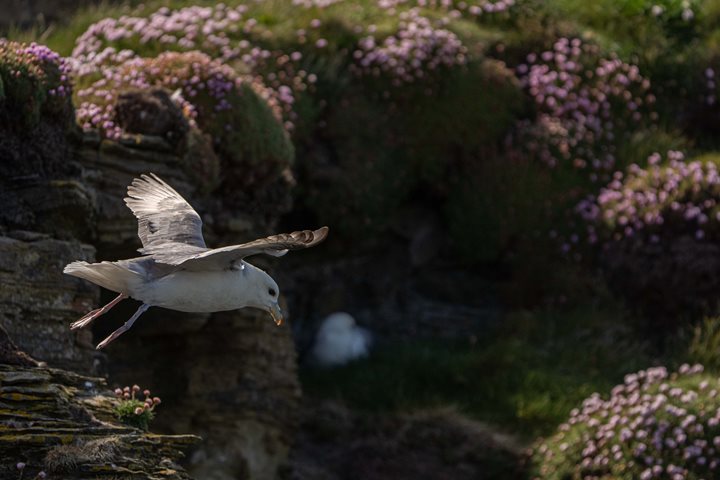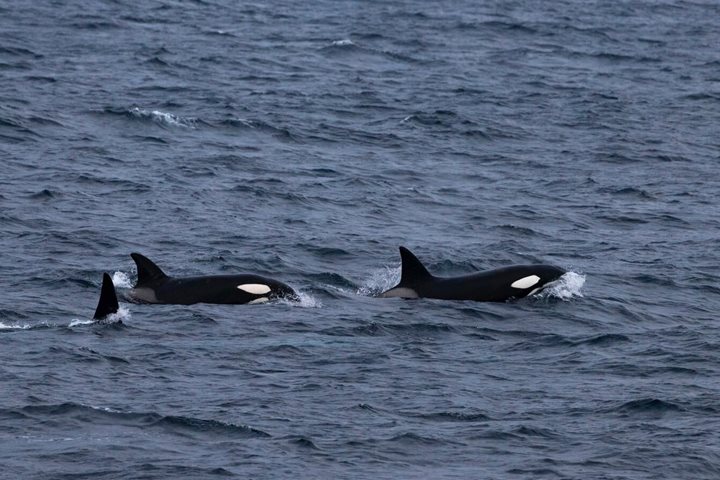This morning, National Geographic Explorer arrived at anchor off the shore of Unst, the third largest of the Shetland Islands and the northernmost inhabited point in the UK. Clouds dispelled to reveal some blue skies as the guests arrived at the dock by Zodiac. Half the group chose to hike to Hermaness Hill at the northernmost tip of the island. Guests encountered spectacular, sweeping views of the landscape, as well as the extensive gannet colony on the cliffs of the Neap. Local sheep also shared in guests’ views of the rugged landscape. The other half of the group embarked on a morning coach tour of some of Unst’s most scenic locations. This offered insight into both the geology and history of the island. The heritage centre and the Boat Haven represent the distinctive lifestyles enjoyed by residents of the island for centuries. A highlight of the tour was a reconstructed Viking longhouse and longboat, which offered a fascinating look back at the Norse heritage of the island. After lunch on board, National Geographic Explorer sailed to Lerwick while guests enjoyed a presentation from the expedition diver. The early evening offered a walking tour and free time in Lerwick, during which guests explored the sights to learn about the history of the city and its Iron Age roots.
- Daily Expedition Reports
- 28 Jun 2023
Unst and Lerwick, Shetland Islands, 6/28/2023, National Geographic Explorer
- Aboard the National Geographic Explorer
- Europe & British Isles
Matthew Whyte, Historian
Born and raised in the south of Ireland, Matthew Whyte is an Art Historian specializing in the visual and cultural history of Italy from the thirteenth to the sixteenth century. He has lectured in University College Cork (UCC) since 2014, and his cur...
Read MoreShare Report
Ancient Isles: England, Ireland and Scotland
VIEW ITINERARYRelated Reports
5/21/2025
Read
National Geographic Explorer
Shetland Islands, Scotland
Today, we had the privilege of experiencing an incredible variety of what the Shetland Islands has to offer – from weather and wildlife to history and music. Our navigation overnight allowed us time to explore a few surprise stops in the morning, including a visit to the Isles of Mousa and Noss. Making a landing at Mousa, we appreciated the craft of ancient builders by visiting the world’s best-preserved broch, dating back to the Iron Age. We then cruised by the cliffs of Noss to the sight of countless seabirds making light work of the impressive Shetland winds and sea conditions. Following an exciting lunch aboard National Geographic Explorer , we settled alongside the town of Lerwick for the afternoon. Here, we ventured out to Jarlshof and Sumburgh Head to hike and visit the iconic Shetland ponies and Atlantic puffins. We also explored the town to learn about local sites, stories, and crafts. To round out our day in Shetland, we were treated to a fantastic performance of fiddle music by a renowned local trio, led by Maurice Henderson.
5/20/2025
Read
National Geographic Explorer
Calanais, Outer Hebrides, Scotland
The morning wakeup call was a little ahead of schedule this morning, but for good reason. We threw on clothes and headed to the bow, blurry-eyed and cameras in hand to marvel at a pod of killer whales swimming off the port side of the ship. Later we jumped in Zodiacs and headed to the awe-inspiring Calanais standing stones. Erected around 2900–2600 BCE on the Isle of Lewis, they form a striking cross-shaped arrangement centered around a stone circle, likely used for ritual or astronomical purposes. Made of ancient Lewisian gneiss, they are among the most significant and mysterious Neolithic sites in Scotland. In the afternoon, we sailed north toward the Shetlands under shifting skies, keeping watch for seabirds and the occasional marine mammal. Our afternoon and evening at sea included two wonderful presentations, ship made scones and cream for teatime, an engaging recap, a special Filipino buffet, and a lively show by the crew band, The Spice Boys.







